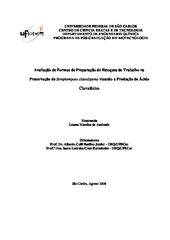Avaliação de formas de preparação de estoques de trabalho na preservação de Streptomyces clavuligerus visando a produção de ácido clavulânico
Abstract
A great deal of microbiological and genetic research in the pharmaceutical industry is directed towards the development of effective strategies in the handling of microorganisms
seeking the production of antibiotics that already known. In the process of obtaining clavulanic acid (CA) from Streptomyces clavuligerus, it is necessary to implement a system of strain conservation to maintain the capacity of microorganisms. Therefore, the purpose of this study was to test different preservation strategies of spores and vegetative cells of S. clavuligerus ATCC 27064 in order to ensure optimum conditions for the production of CA. Eight sets of vegetative cells stored in cryotubes were prepared, and they were evaluated for 12 months according to the number of growth stages (one or two 24-hour stages), the
influence of the mycelium washing stage (washed or not), and the concentration of the cryoprotective agents (glycerol 10 or 20% v/v). Two sets of spores stored in cryotubes were
also evaluated according to the concentration of cryoprotective agents. All cultures were performed in a rotating table incubator using the culture medium ISP1 for reactivation and complex medium for the production of CA. Morphology, cell growth, and the production of CA were evaluated in all cultures. The major findings were that the conservation of spores with 10% glycerol (E-10) allowed a more viable condition that the E-20 during the 360 days
of storage, and the loss of CA production after 360 days was 18% but the condition E-20 was 50%. CL1-20 and CL2-20 were the best preservation conditions (more stable) for
vegetative cells stored in cryotubes. Regarding the production of CA obtained, the maximum value was 1300 mg.L-1 at 144 h in the CNL 2-20 preservation condition.
